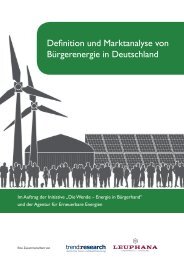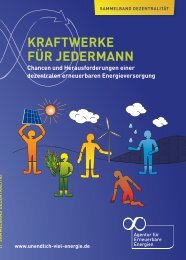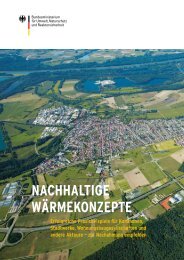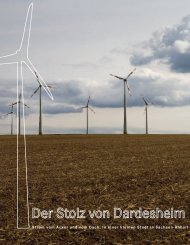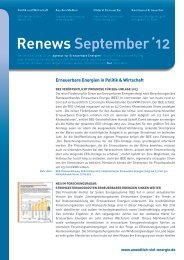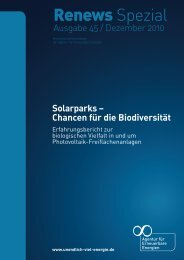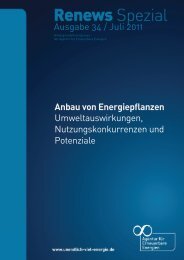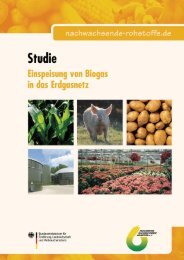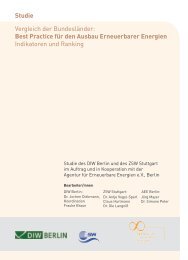Solar parks - Agentur für Erneuerbare Energien
Solar parks - Agentur für Erneuerbare Energien
Solar parks - Agentur für Erneuerbare Energien
Create successful ePaper yourself
Turn your PDF publications into a flip-book with our unique Google optimized e-Paper software.
Renews Special Best practice recommendations Issue 45 | p 18 p 19 | Issue 45 Renews Special <strong>Solar</strong> <strong>parks</strong> – Opportunities for Biodiversity<br />
2. Best practice recommendations: Nature conservation measures<br />
2.1. Measures during the planning stage<br />
a. The relevance of site selection<br />
Decisions are taken at the planning stage that will have a significant influence on the environmental<br />
impacts of the solar park during its construction and operation. These include the choice of site. In<br />
general, the following types of site are important for biological diversity and can therefore only be<br />
considered for solar power production with certain restrictions:<br />
• Sites protected by international conventions (Natura 2000 Special Protection Areas for birds, and<br />
Special Areas of Conservation under the Habitats Directive)<br />
• Sites protected by national and regional regulations (e.g. national <strong>parks</strong>, nature reserves, nature<br />
<strong>parks</strong>, under Section 30 of the German Nature Conservation Act (BNatSchG) and relevant regional<br />
nature conservation laws)<br />
• Sites with specially protected biotopes (Section 30 BNatSchG or relevant regional nature conservation<br />
laws)<br />
In particular cases, however, like that of the Lieberose solar park, solar projects can be realized even on<br />
these sites. However, it may be necessary to plan for significant extra costs for all phases of the project.<br />
Sites that are generally unproblematic in terms of nature conservation are:<br />
• Contaminated brownfield sites previously used for military, commercial or residential purposes, with<br />
a large proportion of sealed area.<br />
• Sites along major transport routes (e.g. motorways)<br />
• Former arable land (under the German Renewable Energy Sources Act, arable land is no longer a<br />
separate category as of 2010, but is often to be found along major transport routes)<br />
• Landfill sites and slagheaps<br />
b. Taking local conditions into account in the environmental impact assessment,<br />
environmental remediation and compensatory measures<br />
As part of the approval process for solar <strong>parks</strong>, local authorities draw up a local development plan<br />
(‘B-Plan’), which includes an environmental impact assessment. The environmental assessment<br />
collects all the concerns relating to environmental protection locally and describes and evaluates them<br />
in an environmental report. The relevant authorities, environmental groups and the public are involved<br />
in the process. It is always advisable to involve the expertise of local nature conservation stakeholders.<br />
This can play a significant role in ensuring that the plant is designed in an environmentally friendly<br />
way and therefore helps increase acceptance. The environmental impact assessment therefore provides<br />
an opportunity to include environmental concerns in the planning procedure. By going beyond the<br />
identification of construction-related environmental impacts, it is possible to plan for measures that are<br />
adapted to the location and make sense in terms of nature conservation.<br />
A change in land use often involves creating measures for environmental rehabilitation and the<br />
development of compensatory measures. This usually results in a considerable improvement to the<br />
environmental quality of a site. The following selected examples describe which measures relating to<br />
the protection of flora and fauna were included in individual environmental reports.<br />
Haar-Salmdorf photovoltaic plant – Planting areas (Not to scale, illustration: Gehrlicher <strong>Solar</strong> AG)<br />
During the planning stage for the solar plant in Salmdorf near Munich, various nature conservation<br />
measuresweredefinedintheenvironmentalimpactassessmentasconditionsfortheplant’sconstruction.<br />
These included avoiding the use of foundations to minimize the sealed area, and stipulations for a chainlink<br />
fence that would let small wild animals like hares, pheasants and partridges through. The solar<br />
plant is on a former field measuring around 6.7 hectares. Most of the surrounding area is dominated<br />
by intensive farming. The area covered by the photovoltaic modules is around 1.1 hectares. Most of the<br />
area was once used as a gravel pit, which was then filled in with building rubble, material excavated<br />
during road construction and refuse. Following restoration with a layer of topsoil, the site had been used<br />
for agriculture. During construction of the solar park, a species-rich meadow was developed, which is<br />
mown twice a year. This led to a significant improvement in the environmental quality of what used to be<br />
a field with few animal or plant species. As well as converting the field to extensive grassland, numerous<br />
measures were implemented to enable an additional improvement in environmental quality. The solar<br />
plant is surrounded by a 4-8 metre wide belt of grassland with a border of hedges and trees. There is<br />
a coppice at the northern end, which also serves as an ecological compensation area. The southern,<br />
south-eastern and south-western edges were planted exclusively with bushes. Around 4000 bushes<br />
and 30 trees were planted on over 15,000 square metres of land. In addition, two ponds were dug on the<br />
site. Construction of the ponds was an important step towards implementing the “green toad scheme”<br />
developed with the city of Munich. It includes the creation of spawning grounds and improvements to<br />
the habitats of these toads, which are at risk of extinction because of intensive building work to the east<br />
of Munich.



